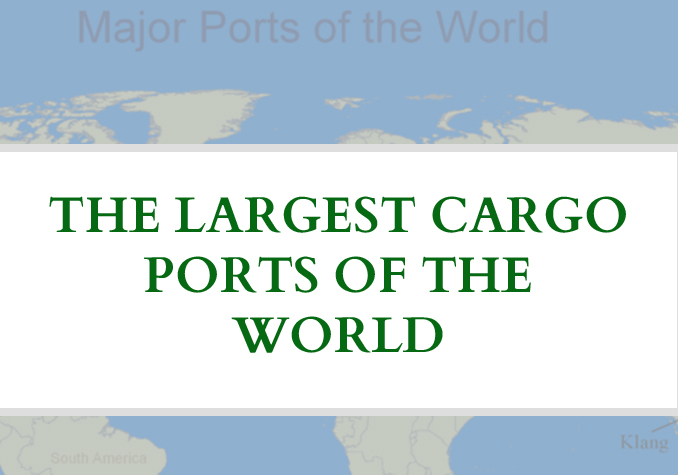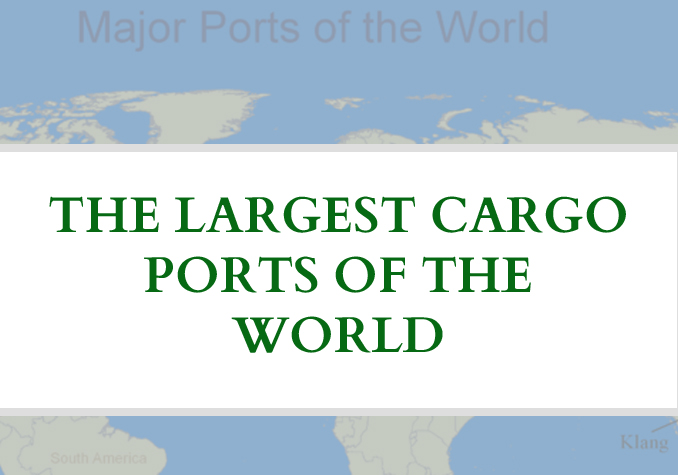More than half largest and busiest cargo ports of the world are own by China, However, remaining are in Singapore, Netherlands and South Korea
Shipping ports are the vital part of world’s oldest means of cargo shipping and are the final destinations for the ships to deliver cargo. World order has changed very swiftly and cargo urgency has been shifted from Europe and U.S to China and Asia Pacific region. Asian Pacific countries including China, Singapore, South Korea and Japan are ruling the world of sea cargo. They own world’s largest and busiest ports where the majority of largest ports is in Chinese region and only one port which ranks as one of the largest ports is in Europe.
Largest ports of the world are as follows
1. Shanghai Port
Shanghai port situated in Shanghai China, is the largest port on the globe. It is an important port for worldwide trade seeing that it’s headquartered to the countless industrial models of adjacent Anhui, Jiangsu, Henan and Zhejiang provinces. For the first time in 2010, the Shanghai port used to be declared the biggest port on the planet. China-based port beat the Singapore port and managed 29.05 million TEU’s, leaving Singapore’s port behind with more than half million TEU’s. In 2014, Shanghai port set a world record with handling over 35 million TEU’s. The port is placed at the delta of the Yangtze River and has an area of 3,619km². Shanghai International Port Group (SIPG) owns the port facility. Wusongkou, Waigaoqiao and Yangshan are the three major container port areas. The port comprises of a hundred and twenty-five berths with a complete quad size of about 16 miles. It serves 2,000 container ships or even more based size, every month and accounts for a quarter of China’s total foreign trade and cargo shipping. It’s a massive port by size and functionality, actually, China loves to make massive things.
2. Port of Singapore
The Port was built in 1819, the Singapore Port known as an economic backbone because of Singapore’s lack in land and natural resources. The port plays an important role in the importation of natural resources, and the re-exporting of particularized merchandises, for example, wafer production or oil filtering to generate revenue. Thousands of ships from across the globe use the Port of Singapore, connecting the port with more than 600 other ports in 123 countries across six different continents. The Port of Singapore handled 537.6 million tons of cargo in 2012, is the second biggest port of the world. The port’s container handling capacity crossed 30 million TEUs mark for the first time in 2012. The port terminals are located at Keppel, Brani, Tanjong Pagar, Sembawang, Pasir Panjang, and Jurong. The terminals are managed by Port of Singapore Authority PSA Singapore and Jurong Port. The port receives an average of 140,000 containers on yearly basis and connects to 600 ports globally. It is equipped with 204 quay cranes and a number of gantry cranes.
3. Tianjin Port
The major port of China. Tianjin port is attached to 21 different adjacent cities and provinces through its dry port. Tianjin is situated in the neighborhood of Beijing and the Northern central provinces, so Tianjin is in a position to help areas from the very North West in Xinjiang, to the North East of internal Neimenggu. The 3rd biggest port in the world is the Port of Tianjin (formerly Tanggu). It handled 476 million tons of cargo in 2012. Located on the mouth of Haihe River in northern China, the port shields 336km² of water and 131km² of land.
It connects to 500 plus ports and serves 189 nations. Tianjin Port is being operated by the port authority. The port facets 159 berths and is made of the southern harbor, the southeast region, Dongjiang Port, the northern port, an economic zone in the southern region and other auxiliary harbors. This record also ends with a China-established port. The Tianjin port counted 13.01 TEU’s in 2013, an enormous rise in comparison with the years earlier. The Tianjin port is peculiarly often called the core of hazardous chemical substances, reminiscent of compressed air, flammable and corrosive substances, oxidizing dealers, and toxic chemicals.
A black page in the history of the port are the 2015 Tianjin explosions, taking location on Saturday the 12th of august. Two explosions inside a minute, prompted by way of an overheated container of dry nitrocellulose, initiated the catastrophe in a container storage station located in the port.
4. Port of Ningbo-Zhoushan
Ningbo-Zhoushan port is used commonly for the delivery of raw materials, manufactured items and cargo across the Chinese region. This port has a significance for import and export of China. The Port of Ningbo-Zhoushan, China, is with a mixed capacity of 873 million tons the busiest on the earth when looking at cargo tonnage. This was executed after the port completed the merger with the neighboring Zhoushan Port crew in 2015.
5. Guangzhou Port
Guangzhou port traditionally transports cargo to and from nearby Jiangxi, Sichuan, Guangxi, Guizhou, and Yunnan Provinces. The Guangzhou port ships many agricultural, industrial and manufactured products. The Port of Guangzhou dealt with around 460 million tons of cargo in 2012, making it the fourth largest port on this planet. The port is positioned in the middle of the Pearl River Delta. It’s operated by the team of Guangzhou Port Authority and dealt with the initial 100 million tons of cargo in 1999.
The port comprises four imperative areas including Downtown Port, Xinsha Port, Huangpu Port and Nansha Port restraints. It’s presently the biggest loading and clearing port for coal in China. Port of Guangzhou is the primary seaport of the city of Guangzhou, Guangdong province, China. The port also serves as the foremost financial and transport center for the Pearl River Delta region and Guangdong province. It is also the primary transport hub for industries placed in neighboring provinces such as Guangxi, Guizhou, Yunnan, Hubei, Hunan, Sichuan and Jiangxi. The port is currently combine to allow 100,000 tons vessels to enter Nansha terminal in low tide.
6. Port of Rotterdam
The Port of Rotterdam is the biggest port in Europe and the sixth biggest on the planet with the aid of annual cargo management. The port dealt with 441.5 million tons of cargo in 2012. The port, together with an industrial demand inside its neighborhood, stretches throughout a size of about 42km, overlaying approximately 12,426ha. It’s managed and operated by the Port of Rotterdam Authority (PoRA). It is the simplest port in north-western Europe that presents unrestricted access to ships with the deepest draughts. An important port expansion project, dubbed as Maasvlakte 2, used to be launched in 2008. The first phase of the growth was opened in 2013 and ultimately double the port’s container switch potential.
7. Shenzhen Port
Shenzen is yet another main port of China considering it is the entry to Hong Kong and the Pearl River Delta. This port links southern China to the sector. The Shenzhen port is the home of over 35 sea shipping and transport companies, joint together for exceptional one hundred thirty worldwide container routes. On a monthly basis, 560 ships are on the name at Shenzhen port and also 21 feeder routes to other ports in the Pearl River Delta.
8. Port of Qingdao
Qingdao port is entered into an association with the primary port in South Korea and three other Chinese ports as a way to produce a transport and logistics center in North East Asia. The Port of Qingdao was built in 1892 and now is a seaport on the Yellow Sea in the neighborhood of Qingdao, Shandong Province, China. The Port of Qingdao is a most important hub for global trade and transportation in the West Pacific. Port of Qingdao, placed at the entrance to Jiaozhou Bay on the south coast of Shandong Peninsula, overlooking the Yellow Sea, and in 2012 it has treated more than four hundred million tonnes of sea cargo. It currently ranks as the eighth biggest port on this planet.
The port is touted as China’s biggest port of crude oil and the world’s largest port for iron ore. The port merges Qingdao historic Port, Huangdao Oil Port and Qianwan New Port, and is connected to more than 450 ports in more than one hundred thirty international locations and areas the world over. Qingdao financial and Technological development area, Qingdao Free exchange Zone and Qingdao high-tech Industrial Zone are placed inside the neighborhood of the port. The port is operated by Qingdao Port team.
9. Port of Dalian
the biggest port in North East China is Dalian and with links to ports in over a hundred and sixty nations. Dalian additionally serves ports in the Pacific Rim, East Asia, and North Asia. Port of Dalian, located on the Liaodong Peninsula in Liaoning province, dealt with 303 million tons of cargo in 2012 ranking and secures the ninth position on this planet. Owned and managed by Dalian Port corporation, the port comprises of seven areas, particularly Daliangang, Ganjinzi, Dalianwan, Heizuizi, Xianglujiao, Si ergo, Nianyuwan, and Dayaowan. The port handles around 70% of the cargo and 90% of the container transportation in the region. It features roughly 80 berths and is hooked up to approximately ninety-nine shipping strains around the world.
10. Port of Hong Kong
The port of Hong Kong has an old significance considering that it is a primary sea cargo shipping hub for hundreds of years. The innovative international strategies and practices make it less expensive. The Port of Hong Kong, placed in the South China Sea, is a deepwater seaport dominated by trade in containerised shipping and passengers. The port is known to be a backbone of development of Hong Kong. The harbor set a statement in its container output in 2007 by dealing 23.9 million TEU’s.














